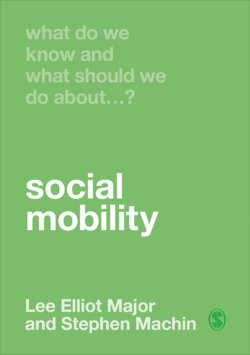Читать книгу What Do We Know and What Should We Do About Social Mobility? - Lee Elliot Major - Страница 14
На сайте Литреса книга снята с продажи.
The Golden Age (1950–70)
ОглавлениеIn 1957, Prime Minister Harold Macmillan famously told the nation: ‘Most of our people have never had it so good.'2 This was indeed a golden era. Social mobility prospects in absolute terms were buoyant. The economy grew by 3 per cent per year between 1950 and 1973. The unemployment rate between 1950 and 1969 averaged just 1.6 per cent (Crafts, 1995).3 The labour market was abundant with decently paid jobs. Income gaps between the highest and lowest earners stayed the same (Armstrong, Glyn and Harrison, 1984). There was widespread belief that a growing economy would improve the lives of everyone – a rising tide would lift all boats.4
A high proportion of people enjoyed upward mobility, filling the expanding jobs in hospitals, universities and central and local government created by the new welfare state (Goldthorpe and Mills, 2004). There was said to be more ‘room at the top'.5 In 1951, the managerial and professional classes made up just 11 per cent of the working male population, while the wage-earning working class made up 55 per cent. By 1971, the managerial and professional classes made up 25 per cent while the working class made up 45 per cent (Goldthorpe, 2016). Among women, the managerial and professional classes grew from 8 per cent to 14 per cent. This was an era of social ascent.
There was also a rapid upgrading and expansion of education. In 1944, the Butler Education Act introduced free secondary education for all and raised the school leaving age from 14 to 15. In 1963, the Robbins Report heralded an expansion of universities and polytechnics. The Robbins principle was established: university degree places ‘should be available to all who are qualified by ability and attainment to pursue them and who wish to do so'. It has remained an unfulfilled aim at the heart of education policy ever since.
In 1940, just 1.5 per cent of working-class 18–19 year olds enrolled on degree courses compared with 8.4 per cent from the professional classes; by 1970, the equivalent figures were 5.1 per cent and 32.4 per cent. It would take another 50 years before the proportion of working classes surpassed the enrolment rate of their more privileged counterparts in 1940. And by that time the professional classes had leaped further ahead.6
The social mobility boom also enriched the country's creative arts: working-class artists, writers and actors emerged in the 1950s and 1960s – from David Hockney to Michael Caine – introducing different voices and perspectives in the arts and theatre, in film and on television.
Yet for all this absolute upward mobility, the golden age did not mean golden tickets for those on the lower rungs of the social ladder to leapfrog over those with higher status. Relative mobility rates remained constant. Macmillan's Conservative government Cabinet in 1957 were uniformly upper class: 94 per cent had been educated at private schools, attended by the 7 per cent of children whose families were able to afford their fees. These enduring social class rigidities may have sowed the seeds of the country's future economic decline. At the very top, the country was missing out on its biggest talent pool, fishing in the same small pond lacking social and cognitive diversity.
While there was room for social climbers to move into the broad professional classes, the door remained firmly closed to the cliques in charge. Sociologists studying elites in the early 1970s found an ‘extraordinary near monopoly exerted by the public schools in general, the influence of the Clarendon schools in particular, and of Eton especially, over elite recruitment in this country’ (Giddens and Stanworth, 1974).
